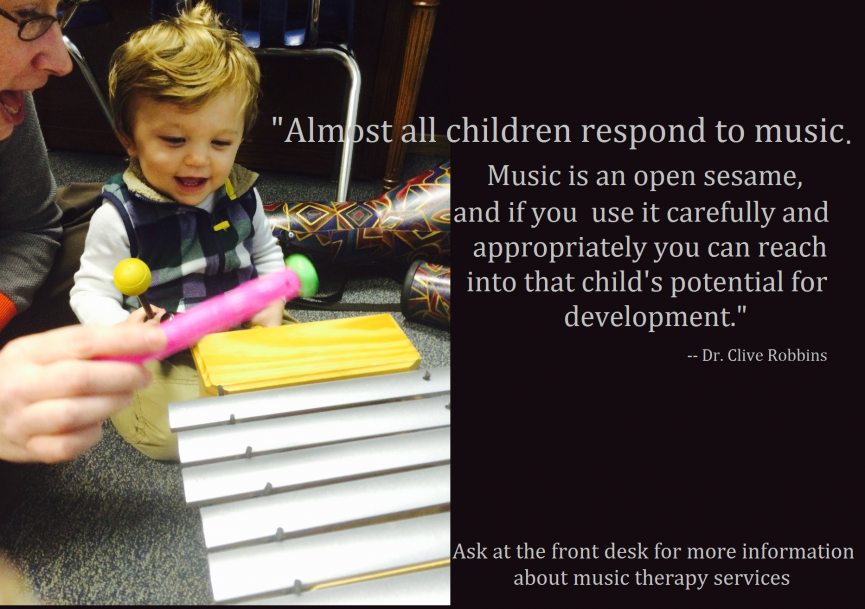<h2> “What Exactly Do You Do in Music Therapy?” <h2>
It is inevitable. If someone asks what I do for a living, the next thing they say is either: “Oh! My kid used to go to Kindermusic. He loves music!” or they ask some form of the question: “What is music therapy?” Both responses make it clear that music therapy is not yet a household term as well understood as speech therapy and physical therapy as this music therapist would hope. Since March is Music Therapy Awareness Month, let’s take a moment together to change that!
It can be hard to picture in your mind exactly what a music therapy session looks like unless you get to see one in action. Some the parents that do get to sit in on their child’s sessions have said that music therapy is like magic. But it’s not magic, it’s science! Music and rhythm are used as tools by music therapists to effect changes in the brain to help improve many skill areas such as communication, motor skills, social skills, emotional and sensory regulation, attention, engagement, memory, and cognitive functioning. Different aspects of music are used in different ways to help achieve this. Let’s look at this with a little more detail.
First, music helps to activate activity in the brain to get it ready to work and learn. When listening to or, even better, when participating in music making multiple areas all over the brain are activated. As a child participates in music therapy neurons are activated throughout the auditory cortex, frontal lobes (structure and planning), mesolimbic system (motivation, pleasure and dopamine production), cerebellum (timing), hippocampus (memory), language centers, visual cortex (watching the movements of instruments, the therapist, and themselves), motor cortex, and sensory cortex. Music making is a whole brain activity; strengthening connections and priming the brain for learning. It is really a neat neuroscientific process that involves neurotransmitters, synchronizing cell firing, and providing a clear signal for the brain to process.
Next, let’s look at a music therapy intervention in action. Imagine a child is playing together with a music therapist on drum while singing: “beat, beat, beat the drum…faster, faster, faster, faster until it’s time to… Stop!!” It looks like fun and games but so much work is going on! The steady rhythm of the therapist’s playing is helping the child to time her responses. The child is practicing grip and functional tool use as she plays the drum. For some clients this could be working on limb isolation (using just o
ne hand), strengthening weak muscles, or improving flexibility or reach/range of motion (reaching out for the drum). Changing the tempo to go faster works on modulating motor skills, motor planning, and joint attention. Signaling to “stop” works on following directions. Stopping also gives opportunity to work on self-regulation (beating that drum can be so arousing! So, we practice taking a break and being able to stay in control of responses), and all throughout there are opportunities to work on oral motor skills and language as a child vocalizes to sing along. After they play this game a few times, the child might stop just before the therapist says stop because the repetition of routine has created a short-term memory response. Perhaps the next session the child will have retained this as a long-term memory response demonstrating learning and retention over time! Who knew so many goals were being addressed all at one time?? And all throughout this work, the child views it as play. That feel good response to music also makes this “work time” rewarding, making the child is more likely to retain those changes. That is the magic of music therapy!
There are many components of music that a music therapist uses to help facilitate growth and learning in children including: rhythm, melody, harmony, tempo, dynamics, cadence, and yes, silence! Prescriptive silences actually help cue responses from a child. A child naturally wants to fill in the blank when the therapist leaves off the last word of a musical phrase or pauses just before the last stressed beat in a familiar rhythm.
Music therapy can often feel like play and is usually naturally rewarding to the brain. Reaching out an arm, isolating a finger, maintaining enough strength to keep that finger from collapsing, then pushing with enough force to depress a piano key can be a lot of work for the brain and body to navigate for a child with motor skill deficits. That is a lot of things that have to happen the right way in the right order to make it happen – but the piano provides an instant reward! The plink of the piano key, the strum of the guitar, and the rat-a-tat of the drum gives motivation to the work in a naturalistic cause and effect way. For some kids, music is the key that reaches them when other therapeutic options have failed.
For more information about music therapy and how it might be used to help develop your child’s potential please talk with your therapists about the benefits of music therapy and our try two program, where you can try two music sessions free of cost!

